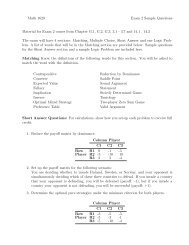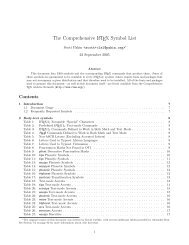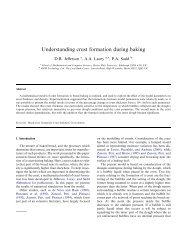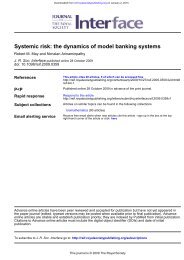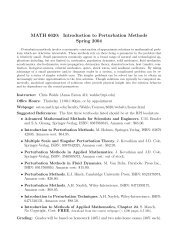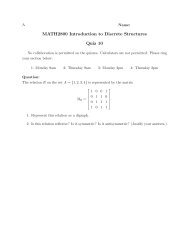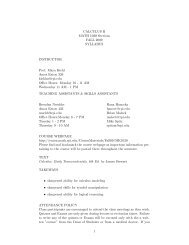A Mathematical Tutorial on SYNTHETIC APERTURE RADAR (SAR ...
A Mathematical Tutorial on SYNTHETIC APERTURE RADAR (SAR ...
A Mathematical Tutorial on SYNTHETIC APERTURE RADAR (SAR ...
You also want an ePaper? Increase the reach of your titles
YUMPU automatically turns print PDFs into web optimized ePapers that Google loves.
A <str<strong>on</strong>g>Mathematical</str<strong>on</strong>g> <str<strong>on</strong>g>Tutorial</str<strong>on</strong>g> <strong>on</strong><br />
<strong>SYNTHETIC</strong> <strong>APERTURE</strong> <strong>RADAR</strong> (<strong>SAR</strong>)<br />
Margaret Cheney<br />
Rensselaer Polytechnic Institute and MSRI<br />
November 2001<br />
• developed by the engineering community<br />
• key technology is mathematics<br />
• unknown in mathematical community<br />
• close c<strong>on</strong>necti<strong>on</strong>s with tomography,<br />
integral geometry, microlocal analysis, seismic inversi<strong>on</strong><br />
1
History<br />
1951 Carl Wiley, Goodyear Aircraft Corp.<br />
mid-’50s<br />
late ’60s<br />
first operati<strong>on</strong>al systems<br />
DoD sp<strong>on</strong>sorship:<br />
U. of Illinois, U. of Michigan,<br />
Goodyear Aircraft, General Electric,<br />
Philco, Varian<br />
NASA sp<strong>on</strong>sorship (unclassified!)<br />
first digital <strong>SAR</strong> processors<br />
1978 SEASAT-A<br />
1981 beginning of SIR (Shuttle Imaging Radar)<br />
series<br />
1990s<br />
satellites sent up by many countries<br />
<strong>SAR</strong> systems sent to Venus, Mars, Titan<br />
2
Outline<br />
• The wave equati<strong>on</strong><br />
• The incident wave: beamforming<br />
• A linearized scattering model<br />
• The received signal<br />
• The rec<strong>on</strong>structi<strong>on</strong> method:<br />
matched filters = backprojecti<strong>on</strong><br />
= migrati<strong>on</strong><br />
• Resoluti<strong>on</strong><br />
• The state of the art<br />
• Current research and open problems<br />
3
<str<strong>on</strong>g>Mathematical</str<strong>on</strong>g> Model<br />
• We should use Maxwell’s equati<strong>on</strong>s.<br />
• A simpler model: the scalar wave equati<strong>on</strong><br />
(<br />
∇ 2 − 1 )<br />
c 2 (x) ∂2 t U(t, x) = 0<br />
• Earth is plane x 3 = 0<br />
• All c<strong>on</strong>stants = 1<br />
4
The Incident Wave<br />
• Field at (t, x) due to a source at the origin at time<br />
0:<br />
δ(t − |x|)<br />
G 0 (t, x) =<br />
|x|<br />
satisfies<br />
(<br />
∇ 2 − ∂ 2 t<br />
)<br />
G 0 (t, x) = δ(t)δ(x)<br />
• But the signal from the antenna is more complicated<br />
.....<br />
δ(t) → P(t) =<br />
∫<br />
e iωt p(ω)dω<br />
δ(x) →<br />
J(x)<br />
5
Field emanating from antenna satisfies<br />
(∇ 2 − ∂t 2 )Uin (t, x) = P(t)J(x)<br />
Solve:<br />
U in (t, x) = G 0 ∗ (PJ)<br />
=<br />
=<br />
∫ P(t − |x − y|)<br />
J(y)dy<br />
|x − y|<br />
∫ ∫ e<br />
iω(t−|x−y|)<br />
p(ω)J(y)dωdy.<br />
|x − y|<br />
In this formula:<br />
Write point <strong>on</strong> antenna as y = γ(s) + q<br />
For x far from the antenna, |q|
∫<br />
Uγ(s) in (t, x) ∼<br />
e<br />
iω(t−|x−γ(s)|)<br />
|x − γ(s)|) p(ω)<br />
∫<br />
· e iω( x−γ(s))·q ̂ J(γ(s) + q)dq dω.<br />
Antenna beam pattern at each frequency is Fourier<br />
transform of current density <strong>on</strong> antenna!<br />
U in<br />
∫ e<br />
iω(t−|x−γ(s)|)<br />
γ(s) (t, x) ∼ p(ω) j(ω( x ̂ − γ(s)), s) dω<br />
|x − γ(s)|<br />
7
Key example:<br />
Take J = characteristic functi<strong>on</strong> of rectangle<br />
j =<br />
∫ L/2<br />
−L/2<br />
∫ D/2<br />
−D/2<br />
e iω[ ̂ x−γ(s)]·(q1 ê 1 (s)+q 2 ê 2 (s)) dq1 dq 2<br />
∝ sinc[ω(D/2)cos θ 1 ] sinc[ω(L/2)cos θ 2 ]<br />
where cos θ j = [ ̂ x − γ(s)] · êj and sinc x = sin x<br />
x .<br />
• Main lobe of beam is perpendicular to antenna<br />
• To get angular width, set argument of sinc =<br />
π, solve for angle.<br />
Antenna has length L ⇒<br />
Angular width of main lobe ≈<br />
ωL 4π = 2λ<br />
L<br />
⇒ width of antenna footprint =<br />
ωL 4π R = 2λ<br />
L R.<br />
• Get a more focused beam with:<br />
– bigger antenna<br />
– higher frequency<br />
8
Linearized scattering theory<br />
(<br />
∇ 2 − c −2 (x)∂ 2 t<br />
)<br />
U(t, x) = P(t)J(x)<br />
(∇ 2 − ∂ 2 t )Uin (t, x) = P(t)J(x)<br />
write U = U in + U sc , c −2 (x) = 1 + V (x), subtract:<br />
( )<br />
∇ 2 − ∂t<br />
2 U sc (t, x) = V (x)∂t 2 U(t, x),<br />
write as Lippman-Schwinger integral equati<strong>on</strong><br />
∫<br />
U sc (t, x) = G 0 (t − τ, x − z)V (z)∂τ 2 U(τ, z)dτdz.<br />
9
single-scattering or Born approximati<strong>on</strong><br />
∫ ∫<br />
U sc (t, x) ≈ G 0 (t − τ, x − z)V (z)∂τ 2 U in (τ, z)dτdz<br />
useful: makes inverse problem linear<br />
not necessarily a good approximati<strong>on</strong><br />
∫ ∫ δ(t − τ − |x − z|)<br />
γ(s) (t, x) ≈ V (z)<br />
|x − z|<br />
U sc<br />
∫ e<br />
iω(τ−|z−γ(s)|)<br />
·<br />
j(ω( z ̂ − γ(s)), s)ω 2 p(ω)dωdτdz<br />
|z − γ(s)|<br />
≈<br />
∫ ∫<br />
e iω(t−(|x−z|+|z−γ(s)|))j(ω( z ̂ − γ(s)), s)˜p(ω)<br />
dω<br />
|z − γ(s)||x − z|<br />
· V (z)dz<br />
At center of antenna,<br />
∫ ∫<br />
Uγ(s) sc (t, γ(s)) ≈<br />
e iω(t−2|z−γ(s)|)j(ω<br />
(z ̂ − γ(s)), s)˜p(ω)<br />
|z − γ(s)| 2 dω V (z)dz<br />
10
This data is of the form<br />
∫ ∫<br />
D(t, s) = e iω(t−2|z−γ(s)|) a(z, s, ω)dωV (z)dz<br />
From D, want to rec<strong>on</strong>struct V .<br />
• D is an oscillatory integral, to which techniques<br />
of microlocal analysis apply ( C. Nolan & M.C.)<br />
• seismic inversi<strong>on</strong> problem with c<strong>on</strong>stant background<br />
but limited data<br />
• D(t, s) depends <strong>on</strong> two variables.<br />
Assume V (z) = Ṽ (z 1 , z 2 )δ(z 3 − h(z 1 , z 2 )).<br />
• if a(z, y, ω) = 1, want to rec<strong>on</strong>struct V from its<br />
integrals over spheres or circles (J. Fawcett,<br />
L.-E. Anderss<strong>on</strong>, A. Louis & E.T. Quinto, M.<br />
Agranovsky & E.T. Quinto)<br />
• character of problem depends <strong>on</strong> frequency c<strong>on</strong>tent<br />
of a<br />
11
High frequency case<br />
• microwave frequencies, ω ∼ 10 9 , λ ∼ cm<br />
• can form narrow beam<br />
• high resoluti<strong>on</strong>, space-borne<br />
• doesn’t penetrate foliage<br />
Low frequency case<br />
• VHF: ω ∼ 10 7 , λ ∼ 10m<br />
• cannot form beam<br />
• penetrates foliage but resoluti<strong>on</strong> is low<br />
• airborne<br />
12
Inversi<strong>on</strong> scheme: matched filter =<br />
backprojecti<strong>on</strong> = migrati<strong>on</strong><br />
I(x) =<br />
∫<br />
P(t − 2|x − γ(s)|)D(t, s)dtds<br />
Why is this called a matched filter?<br />
Take V (z) = δ(z − x) in<br />
∫ ∫<br />
D(t, s) = e iω(t−2|z−γ(s)|) p(ω)j(ω(z ̂ − γ(s)), s)dω<br />
·<br />
V (z)<br />
|z − γ(s)| 2dz<br />
j is nearly independent of ω ⇒<br />
D(t, s) ∝ P(t − 2|x − γ(s)|)<br />
= data due to a “point scatterer” at positi<strong>on</strong> x.<br />
In case P = δ:<br />
The matched filter “backprojects” the data over<br />
the sphere with radius t/2 and center γ(s).<br />
Image at x is formed by adding data corresp<strong>on</strong>ding<br />
to all spheres passing through x.<br />
13
Why does matched filter processing give us<br />
an image?<br />
D(t, s) =<br />
∫ ∫<br />
e iω(t−2|z−γ(s)|) a(z, s, ω)dωV (z)dz = FV<br />
Apply<br />
I(x) =<br />
∫ ∫<br />
e i˜ω(t−2|x−γ(s)|) p(˜ω)d˜ωD(t, s)dtds ≈ F ∗ D<br />
Note that phase is negative of phase of D.<br />
Compare with Fourier inversi<strong>on</strong>, Rad<strong>on</strong> transform<br />
inversi<strong>on</strong>, ....<br />
Use<br />
∫<br />
e it(˜ω−ω) dt = δ(˜ω − ω)<br />
to get<br />
I(x) =<br />
∫<br />
W(x, z)V (z)dz<br />
where<br />
W(x, z) =<br />
∫ ∫<br />
e 2iω(|x−γ(s)|−|z−γ(s)|) p(ω)a(z, s, ω)dωds<br />
is the point spread functi<strong>on</strong> or generalized ambiguity<br />
functi<strong>on</strong> of the imaging system.<br />
14
∫<br />
I(x) =<br />
W(x, z)V (z)dz<br />
W(x, z) =<br />
∫ ∫<br />
e 2iω(|x−γ(s)|−|z−γ(s)|) p(ω)a(z, s, ω)dωds<br />
Main c<strong>on</strong>tributi<strong>on</strong> comes from:<br />
• (high frequency case) x = z <strong>on</strong>ly<br />
• (low frequency case) x = z and<br />
x = reflecti<strong>on</strong> of z<br />
wavefr<strong>on</strong>t relati<strong>on</strong> of F is<br />
a folding can<strong>on</strong>ical relati<strong>on</strong><br />
⇒ artifacts<br />
15
Resoluti<strong>on</strong> in high frequency case<br />
How close is W to a delta functi<strong>on</strong>?<br />
W(x, z) =<br />
∫ ∫<br />
e 2iω(|x−γ(s)|−|z−γ(s)|) p(ω)a(z, s, ω)dωds<br />
Compare with δ(x − z) = ∫ e i(x−z)·ξ dξ.<br />
G. Beylkin (JMP ’85) approach:<br />
1. Do Taylor expansi<strong>on</strong> of exp<strong>on</strong>ent:<br />
|x − γ(s)| − |z − γ(s)| = (x − z) · Ξ(x, s, z)<br />
near x = z, Ξ(x, s, z) ≈<br />
̂ z − γ(s)<br />
2. Make change of variables (ω, s) → ξ = 2ωΞ(x, s, z):<br />
∫<br />
W(x, z) = e i(x−z)·ξ ∂(s, ω)<br />
p(ω(ξ))a(z, s(ξ), ω(ξ)) dξ<br />
∂ξ<br />
This is kernel of a pseudodifferential operator ⇒<br />
puts singularities in the correct locati<strong>on</strong>s.<br />
16
∫<br />
W(x, z) =<br />
e i(x−z)·ξ ∂(s, ω)<br />
p(ω(ξ))a(z, s(ξ), ω(ξ)) dξ<br />
∂ξ<br />
Resoluti<strong>on</strong> is determined by support of p(ω(ξ)) and<br />
a(z, s(ξ), ω(ξ)), i.e., by bandwidth and angular extent<br />
of survey.<br />
Resoluti<strong>on</strong> via Fourier transforms<br />
∫ b<br />
−b<br />
e iρr dρ =<br />
2sin br<br />
r<br />
corresp<strong>on</strong>ds to resoluti<strong>on</strong> 2π/b.<br />
17
Al<strong>on</strong>g-track (azimuthal) resoluti<strong>on</strong><br />
W(x, z) =<br />
∫<br />
with ξ ≈ 2ω<br />
e i(x−z)·ξ ∂(s, ω)<br />
p(ω(ξ))a(z, s(ξ), ω(ξ)) dξ<br />
∂ξ<br />
̂ (z − γ(s)).<br />
If flight track is γ(s) = (0, s, H) and<br />
x − z = (0, x 2 − z 2 ,0), need <strong>on</strong>ly<br />
ξ 2 ≈ 2ω z 2−γ(s) 2<br />
R<br />
= ω R 2(z 2 − s)<br />
But<br />
2max |z 2 − s| = width of antenna footprint<br />
=<br />
ωL 4π R = 2λ<br />
L R<br />
= effective length of the synthetic aperture<br />
So max |ξ 2 | ≈ ω R 4πR<br />
ωL = 4π L<br />
So resoluti<strong>on</strong> in al<strong>on</strong>g-track directi<strong>on</strong> is<br />
2π<br />
4π/L = L 2<br />
18
Al<strong>on</strong>g-track resoluti<strong>on</strong> is L/2.<br />
This is ...<br />
• independent of range!<br />
• independent of λ!<br />
• better for small antennas!<br />
These are all explained by noting that when a point<br />
z stays in the beam l<strong>on</strong>ger, the effective aperture<br />
for that point is larger.<br />
In range directi<strong>on</strong>, want broad frequency band ⇒<br />
get largest coverage in ξ.<br />
19
The state of the art (high frequency)<br />
• Can correct for antenna moti<strong>on</strong><br />
• interferometric <strong>SAR</strong> (two flight passes or two<br />
antennas)<br />
– topographic informati<strong>on</strong><br />
– changes (glacier flow, volcano movement)<br />
• polarimetric <strong>SAR</strong> (uses full Maxwell’s equati<strong>on</strong>s)<br />
• MTI = Moving Target Indicator<br />
• <strong>SAR</strong> in wave mode: Use subaperture<br />
informati<strong>on</strong> to get ocean moti<strong>on</strong><br />
20
Current research and open problems<br />
• Foliage-penetrating (FOPEN) <strong>SAR</strong><br />
– low frequencies ⇒ poor directivity ⇒<br />
tomographic image formati<strong>on</strong> from<br />
integrals over circles or spheres<br />
– want bare earth topography<br />
– want to find tanks under trees<br />
– want to estimate forest biomass,<br />
trunk volume, tree health<br />
• Ground-penetrating radar (GPR)<br />
– land mines<br />
– unexploded ordinance (UXO)<br />
• Ultra-wideband (UWB) <strong>SAR</strong><br />
21
• Improved modeling<br />
– dispersi<strong>on</strong> (FOPEN)<br />
– multiple scattering<br />
∗ rough terrain, wave-guiding structures<br />
∗ wave propagati<strong>on</strong> in random media, clutter<br />
• Image interpretati<strong>on</strong><br />
– thickness of ice, species of trees,<br />
surface roughness, . . .<br />
– Automatic Target Recogniti<strong>on</strong> (ATR)<br />
(school bus or tank?)<br />
– sensor fusi<strong>on</strong>, use of multiple frequency bands<br />
22
• Theoretical issues<br />
– Uniqueness theorem for backscattering<br />
– Rec<strong>on</strong>structi<strong>on</strong> for full n<strong>on</strong>linear inverse problem<br />
∗ limited aperture<br />
∗ time domain (including dispersi<strong>on</strong>!)<br />
– What are theoretical limits?<br />
23
References<br />
• M. Cheney, “A mathematical tutorial <strong>on</strong> <strong>SAR</strong>”,<br />
SIAM Review, SIAM Review 43 (2001) 301-<br />
312; http://www.rpi.edu/∼cheney/sar.ps<br />
• G.W. Stims<strong>on</strong>, Introducti<strong>on</strong> to Airborne Radar,<br />
Scitech Publishing, New Jersey, 1998.<br />
• C. Elachi, Spaceborne Radar Remote Sensing:<br />
Applicati<strong>on</strong>s and Techniques, IEEE Press, New<br />
York, 1987.<br />
• G. Franceschetti and R. Lanari, Synthetic Aperture<br />
Radar Processing, CRC Press, New York,<br />
1999.<br />
• L.J. Cutr<strong>on</strong>a, “Synthetic Aperture Radar”, in<br />
Radar Handbook, sec<strong>on</strong>d editi<strong>on</strong>, ed. M. Skolnik,<br />
McGraw-Hill, New York, 1990.<br />
24


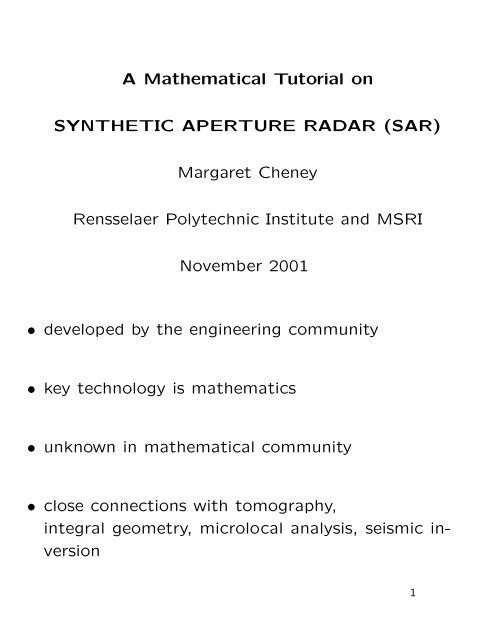
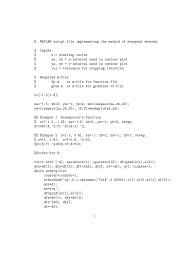

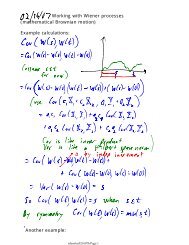

![MATH 1500 Sample Questions Exam 2 1. [3.7] A 10-ft plank is ...](https://img.yumpu.com/43861920/1/190x245/math-1500-sample-questions-exam-2-1-37-a-10-ft-plank-is-.jpg?quality=85)
